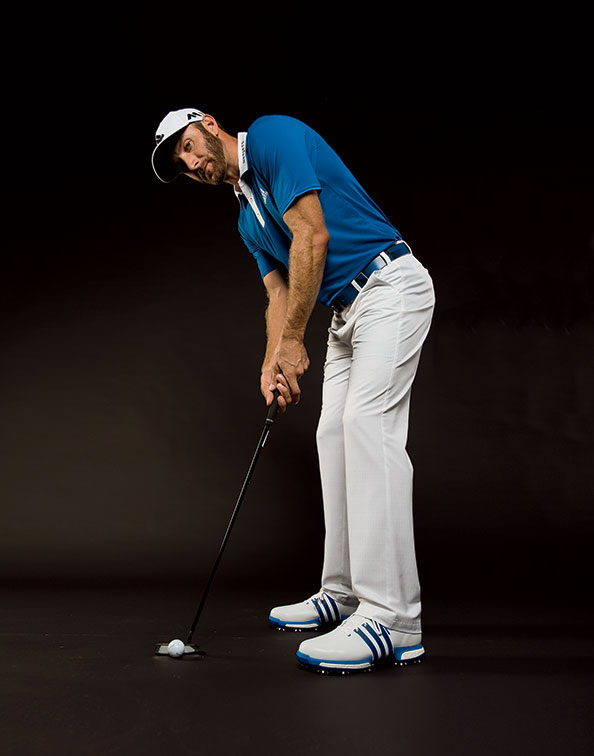When I look at a golf course, I don’t see trouble. I see opportunities.
It might have tight fairways or heavy rough or be super long – that’s fine by me. On tour, we expect a tough test. But I’m not sure everyone has that kind of mind-set. I think a lot of golfers see a hard hole or stretch of holes, and instead of revving up, they get defensive. Before they even put their tee in the ground, they’re thinking about avoiding double-bogey, not how they can par this sucker. Assuming you’re playing from the right tees for your skill level, there’s no reason to let any hole routinely beat you up. I’ll show you how to turn the tables on tough holes, from tee to green, so you can become the bully. — with Ron Kaspriske
1. TEE
Here’s where most amateurs go wrong: Instead of being aggressive, they opt for the safe play. That approach is fine if you commit to it and put a good swing on the ball, but that’s not what usually happens. Most people go into “steering mode” when faced with a tough tee shot. When you try to guide the ball, your swing gets short and hesitant, and you usually end up in trouble. I don’t know about you, but if my drive is going to find the junk, I’d rather be 50 metres closer to the hole.
At the US PGA Championship at Whistling Straits last year, I started on No.10. It has a bunker in the middle of the fairway that calls for a 260-metre carry. Catch the bunker, and you’re looking at bogey or worse. When I was warming up, my coach, Butch Harmon, said it might be good to hit 4-iron to avoid the sand. I said, “Nah, I’m just going to send it.” He loved that term. I ended up flying the bunker and making 3.
So here’s my advice: Grab your driver, think about the best tee shot you’ve ever hit, and send it. Make sure you take your time going back. Before you start down, feel like you can’t turn back any farther [below]. You’ll store extra power and give yourself more time on the downswing to square the face so you put the ball in the short grass.

2. FAIRWAY
Assuming you took my advice and hit a decent drive, you gave the hole a nice punch to the gut. But he’s not down yet. You need to be equally aggressive with your irons. I don’t mean fire at a pin tucked next to a water hazard. I’m talking about what you need to do to that little white ball – you’ve gotta go get it.
On the final hole of last year’s US Open, a 550-metre par 5, I needed a birdie to tie Jordan [Spieth] and an eagle to win. I swung almost 100 per cent off the tee and ripped one way down the narrow fairway. I had 230 left, but I thought I could get a 5-iron there because of the helping wind and firm ground. Still, I really had to step on the ball. Because I went after it, I made a free swing and knocked my approach to 12 feet.
When I say you’ve “gotta go get it,” that doesn’t mean I want you to swing so wildly you lose your balance. Start with a nice, stable base, a little wider than normal. Then try to smash down on the ball. You’ll notice here that my head has already turned towards the target [below]. I do this instinctively before impact to allow a full, free-flowing move through the ball. Keeping your head locked down only restricts your swing – and your distance. I let my head swivel to make sure I keep my swing speed up through the ball.

3, WEDGE
Whether you’re trying to take down a par 5 or your aggressive iron shot on a par 4 missed the green, there are times when you’ll need to be an assassin with your wedge. First thing to do is throttle back from your approach-shot mind-set. Because my full swing is so long, I tend to over swing my wedges. I either shut the face or have to decelerate to avoid airmailing the green. If you want to hit great wedge shots, you need to gather yourself like you just went from a fast break to shooting a free throw because you got fouled.
At the HSBC Champions in November, I was in contention on Sunday and had a short pitch on the par-5 eighth hole to set up a birdie. I hit a sweet little shot, but the ball hit the base of the flagstick and caromed off the green and into a water hazard. Bad luck, but I’m still happy with that shot because I pulled off what Butch and I have been working on with my wedges.
To hit these wedge shots tight, make a shorter, wider backswing [below]. Feel the extension in your arms, and resist the urge to let the club keep going back with any unnecessary wrist action. Then just let everything – club, hands, arms and body – come through together. You should get it close enough to have a legit birdie putt.

4. GREEN
You know what makes you miss more putts than anything? The fear of missing. You need to think like AFL defenders do. If they get beat in a marking contest, they get back on the bike and get ready to spoil the next one. Last year on tour I had the second-lowest putts-per-round average on Sundays. For me, part of bullying a hole is thinking you can make any putt, especially when it comes down to crunch time.
On that final hole of the US Open last summer, I could have trickled the ball down near the cup in hopes of getting a short putt to force a playoff. But I tried to make the eagle putt for the win, and it rolled four feet past. Missing the next one didn’t bother me like you might think, because I gave that green my best shot. The thrill of being in that situation and not cowering is what I’ve taken from that day.
To make the tough ones, you’ve got to trust your feel. As you read a putt, try to get a sense for the pace you’ll need. Then, when you get over the ball, keep your eyes trained on the hole [below]. Don’t worry about body positions or how precise your aim is. Your body will naturally adjust if you’re looking at your target.
Finally, look back to the ball and go. You’ll give it a really good roll and know you didn’t let the situation get to you. That’s a great goal for any shot going forward: Be a bully.





